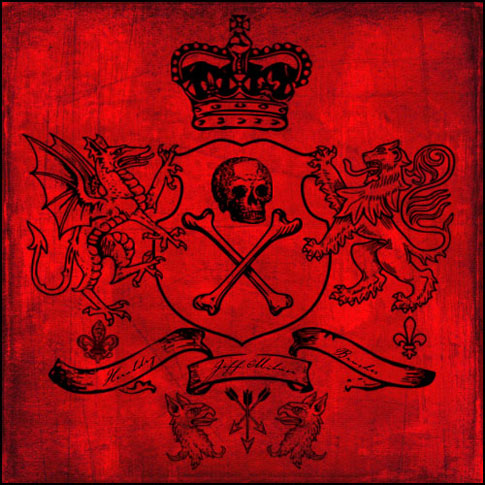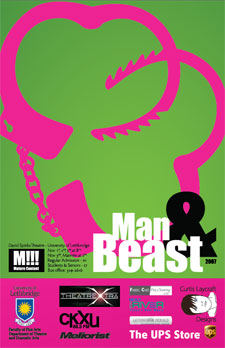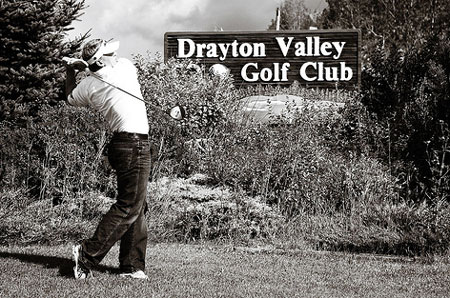The best images of 2007 as picked out by Time. (Someone needs to teach the time.com web developers the magic of AJAX).
Heraldic Brush Set
The other day I came across a neat collection of “Heraldry Brushes” by MrTentacleGuy on deviantART. I was disappointed to find out that the brushes were actually in vector format and while great for resizing and maintaining their original integrity in Illustrator, not very handy for quick and dirty Photoshop work where a brush set (.abr) is all you really want.
So I took his heraldry vector collection and made it into a brush set. I’m releasing it under the same Creative Commons Attribution 3.0 License. Here is a little sample I threw together using the new brushes (sorry the red background is not part of the set).

Download the Heraldic Brush Set (.zip)
There are over 70 high resolution brushes in this set! If you use it, please leave a comment and don’t hesitate to link back to your work as well.
From Wednesday’s Photoshoot
Man & Beast
 There is a new play opening at the U of L on Thursday. It’s a bit out there for my usual theatrical consumption, however, I think sometimes it’s good to challenge yourself and can you really go wrong with a play about sex?
There is a new play opening at the U of L on Thursday. It’s a bit out there for my usual theatrical consumption, however, I think sometimes it’s good to challenge yourself and can you really go wrong with a play about sex?
Director Ben Hart gave me a ticket to see this show, so I guess I’ll find out on Thursday.
Continue reading “Man & Beast”
Viva Las Vegas
I realize it has been a long time since I’ve posted anything here, but I’ve been busy!
Most recently I’ve found myself down in Mesquite, Nevada getting ready to watch my brother-in-law compete in the World Long Driving Competition.
Today my family and I drove to Las Vegas to take in the sights and sounds of the notorious city. I’d share everything that I did, but you know what they say about what happens in Vegas.
If you’re so inclined, you can check out and comment on some of my flickr photos from today’s travels.
Continue reading “Viva Las Vegas”
Fantoche (2 times) Wall Animation
I did a bit of sketching with charcoal for a drawing class in University. One of the projects I did involved drawing something, erasing it and redrawing the same thing after some action had happened.
 Because charcoal leaves marks behind after it’s erased, the original action could be seen behind the new drawing. I repeated these steps about 5 or 6 times. To the left is my artwork (click to view bigger).
Because charcoal leaves marks behind after it’s erased, the original action could be seen behind the new drawing. I repeated these steps about 5 or 6 times. To the left is my artwork (click to view bigger).
It was a lot of work for, what I consider to be, not a great payoff. I like to think that the work has some good conceptual value, even if it’s not that interesting to look at.
The following is a truly amazing wall animation that works on the same principle. (It would have been smart of me to document each step of the process in photographs too).
Realizing how much work went into the poster sized effort I created in University, I’m blown away by the amount of time and effort that it must have taken to create this video. Not only is each individual frame beautifully crafted but the animation is also wonderful. Please enjoy, Fantoche:
[Fantoche – YouTube]
Imagine Peace Tower
Yoko Ono is about to unveil the Imagine Peace Tower in Videy Island, Reykjavik, Iceland on October 9th 2007, John Lennon’s birthday. The tower will exist in the form of light shooting into the sky and symbolizes love, peace, and harmony.
Despite what some may criticize as a new age, hippie, pipe dream—I think it’s pretty nice.
The IMAGINE PEACE TOWER is an artwork conceived by Yoko Ono in memory of John Lennon.
It is dedicated to peace and bears the inscription IMAGINE PEACE in 24 languages.
Its construction and installation is a collaboration between Yoko Ono, the City of Reykjavik, Reykjavik Art Museum and Reykjavik Energy.
The work is in the form of a wishing well from which a very strong and tall tower of light emerges. The strength, intensity and brilliance of the light tower continually changes as the particles in the air fluctuate with the prevailing weather and atmospheric conditions unique to Iceland.
Every year it will light up between October 9th (Lennon’s birthday) and December 8th (the day of his death).
In addition the IMAGINE PEACE TOWER will be lit on New Year’s Eve, during the first week of spring and on some rare special occasions agreed between the City and Yoko Ono.
Glen Hutchinson in the World Long Drive Competition
My brother-in-law, Glen, was in Wyoming a couple weeks ago competing in an Open Long Drive competition and ended up winning a ticket to the Re/Max Long Drive World Championship Tournament in Mesquite, Nevada this October.

Longdrivers.com lists him as the Open Division Winner with a distance of 337 yds 24 inches. I’m looking forward to watching him progress through the 11 rounds that it takes to win the Championship in Mesquite.
(Photo credit to Glen’s talented wife Jackie Hutchinson. IMHO she’s the best photographer in Drayton Valley Okotoks.)
John Lennon’s Jukebox
A few years ago a jukebox owned by John Lennon was discovered. On it were 40 of the famous musician’s favorite tunes. This is a documentary about the songs on that Jukebox and the influence they had on the Beatles.
[John Lennon’s Jukebox | YouTube]
The Amazing Intelligent Resize
Currently if you have a large image that you need to make smaller for the web you can either scale it or crop it. Scaling makes everything smaller and cropping can cut out important content. This incredible video demonstrates an image re-sizing algorithm that is content-aware. It’s pretty cool and I figure it’s something that is going to make someone a boatload of money.
[Content Aware Image Sizing – YouTube]

